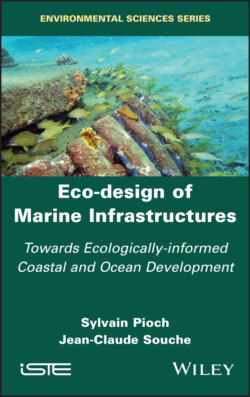Читать книгу Eco-design of Marine Infrastructures - Sylvain Pioch - Страница 19
1.3.3. Artificial marine habitats: Japanese origin of inspiration for eco-design
ОглавлениеJapan is undoubtedly considered as the world leader in the successful management of the seabed, as much in terms of application (stability of coastal fisheries) as perspective (Bailly 1989; Baine 2001). Extensive coastal mariculture (or marine-ranching) began with the great interest of this maritime nation in the creation of “fish houses”, habitats adapted to the needs and functions necessary to increase underwater life. Thus, the first Japanese reefs, or artificial habitats (AHs), were described between 1652 and 1655 (during the reign of Emperor Jôo). They consisted of wrecks filled with stones to extend the exploitable fishing areas near the village. The technical description is very precise, and the choice of materials (stones and timber from ships) is linked to questions of habitat (volume, ecological functions, target species, stage of development) and durability. However, it was not until the 20th century that this structural diversity really developed in Japan, and then from the 1950s onwards for the rest of the world.
The first modern (disseminated) Japanese studies on AHs date back to 1903 (Fukuoka Prefecture), with the most important trials starting in 1952 with the first governmental plan for “development of shallow water fishing areas” (Simard 1996). The Japanese public investment for the creation of AH infrastructures in 2007 alone was 602 million euros (93.318 billion yen), with an average between 2000 and 2005 that was fairly stable at approximately 600 million euros per year (Japanese Institute of Fisheries Infrastructure and Community17). In 2001, an audit launched by the French Ministry of Agriculture, Fisheries and Forestry (MAFF) found that more than 12% of the continental shelf was developed with about 20,000 sites (Lacroix et al. 2002). In 2007, there were over 222 AH models referenced by the JIFIC (Pioch 2008). These figures allow us to imagine the immense amount of technical and ecological knowledge that has been developed to understand the marine species/habitat relationship. We will return to the contribution of this work, which we use to design structures that deploy habitats and functions adapted to local species, in Chapter 3.
NOTE.– In Europe, habitats are defined according to the European Nature Information System (EUNIS) habitat (and settlement) classification method. This typology of habitats is the most commonly used. It is a habitat classification reference for terrestrial, freshwater and marine areas (defined via the Rebent Ifremer network). This typology has been used to determine the major physical habitat types of the French seabed. It is also used to characterize the determining habitats of marine natural zones of ecological interest, fauna and flora (ZNIEFF). This typology is based on a hierarchical classification of habitats, which can be measured to different levels of precision, ranging from the simple distinction between rocky and soft types (level 2) to the precise identification of benthic populations (levels 5 and 6). These benthic communities are characterized at the level of each major habitat type: a major benthic habitat type corresponds to one or more habitat types as defined in the EUNIS classification (Bajjouk et al. 2015).
This national reference system defines a common language to facilitate the implementation of public conservation policies and makes it possible to inventory the habitats present in metropolitan France. Its use is recommended for all programs related to the conservation of marine habitats on a national scale.
New regulatory requirements are leading to changes in coastal development practices. The purpose of this work is not to recall the regulatory principles relating to environmental or urban planning law; we refer the reader to the many specialized works on the subject. However, we believe it is useful to indicate recent developments, as they corroborate the interest of project owners and their consulting firms in applying an eco-planning approach.
Indeed, protecting the environment is not only about conserving spaces and species and classifying territories to protect them from human activities. It also means integrating the environment into planning actions and development projects, which are the subject of this book, and therefore designing projects that are respectful of humans, landscapes and natural environments and concerned with saving space, sparing species and limiting water, air and soil pollution.
